It’s somewhat common to hear the phrase “I have a studio space in my house.” Many artists have a home art studio that is a converted bedroom, an unused dining area, a corner of the basement, or an otherwise empty attic. Having some type of dedicated space for one’s art is so important.
But when Lori Putnam told me that her house was in her studio, I had to find out more. She explained that she and her husband, Mark, didn’t originally intend to live in her art studio, although now it seems like a no-brainer. “It’s not for everyone, but it’s perfect for us,” she said.
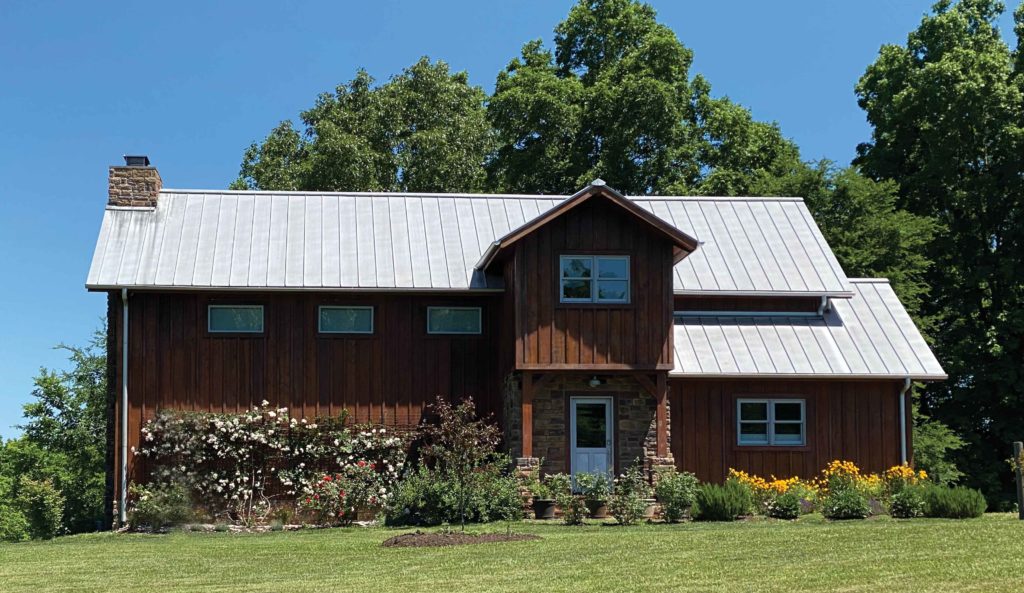
The Perfect Art Studio
The original plan was to first build an art studio on their new property and temporarily live in the studio’s loft until their home was completed. The space, then, was designed only with art in mind: It’s a single, large room with high ceilings and north light with a small kitchen area and loft. The only door in the space, Lori says, is for the bathroom.
“People don’t even realize it’s our actual home at first,” Lori said. As they lived in the loft, they found that they didn’t need a separate house at all. “It feels like a studio and a home,” she said, “We’d still be over here if we had a house. Of course, it is a very large loft, so that may be part of it.”
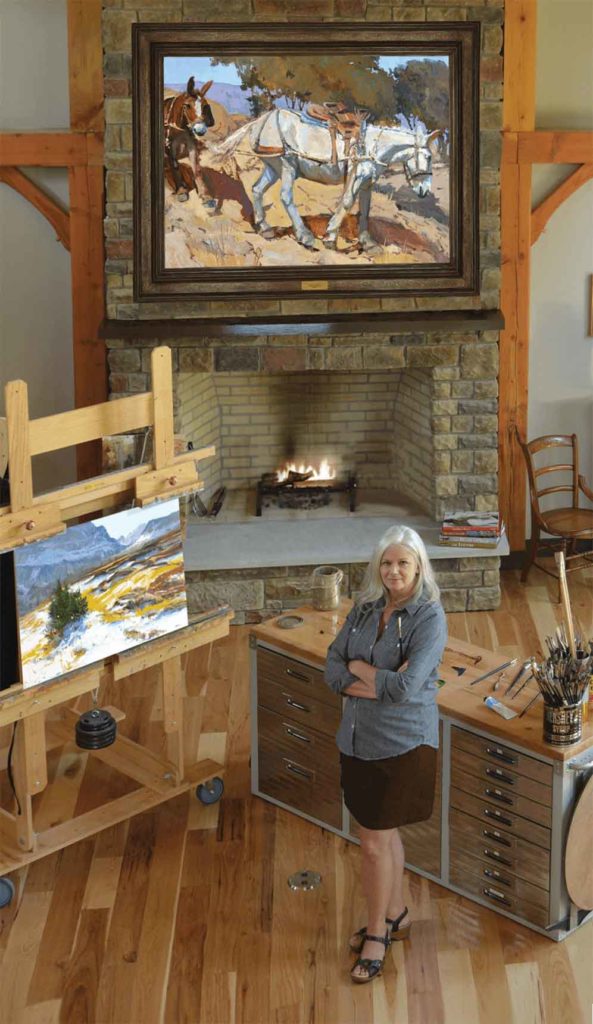
Studio First
Because the space’s priority is art, it’s treated like a studio, complete with paint on the floor, and minimal, multi-functional furniture. “It had to be a studio first,” Lori said.
There are some comfortable chairs, a television that can also be used as a monitor for painting, and a long dining room table (one of the few things they kept when they sold their house prior to building the studio). The table itself has sentimental value, and so when Lori teaches workshops there, they move the table to the side of the room and cover it with plastic so that students can use it and also to protect it.
Speaking of her workshops, the space can hold up to 20 students with plenty of room to spread out. Lori simply moves her chairs upstairs to the loft, which is the only private area. It serves as the bedroom and contains their personal items, such as musical instruments and anything that doesn’t pertain to painting.
It might be a small space to contain both an art studio and a home, but Lori says that being organized helps. She has cabinets dedicated to her painting supplies, and admits that you might find a dish or two in them. Quoting what she told her husband, who does most of the cooking, “Mark, I’m going to give you three cabinets,” she laughed, adding that while she makes use of most of the space as an artist, she doesn’t paint in the kitchen.
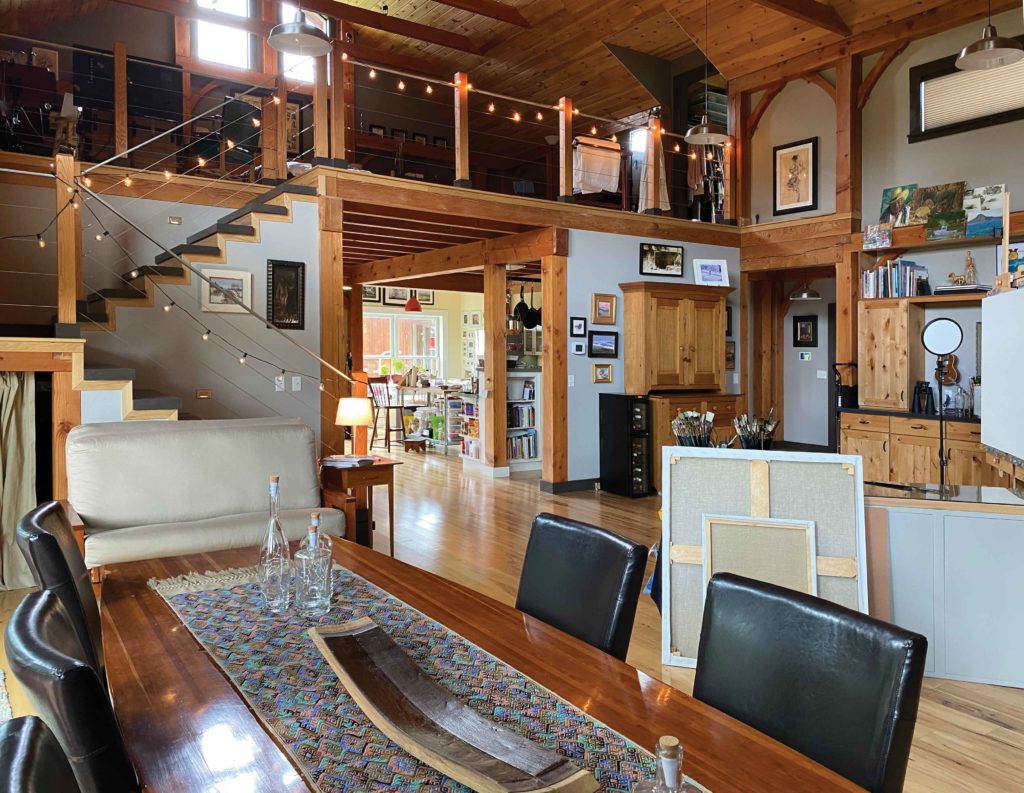
Art Studio Ideas
How does one create the perfect art studio? Lori shares some of the most important elements of her space:
- Inspiration. “You hear that you should only have your own work in your studio,” Lori said, explaining that this way when potential buyers and collectors come in, they only see your work, but “I have it packed with paintings by my friends,” she says. “I feel like I have my friends there with me while I’m painting.”
- A “taboret” that is actually a tool-chest set up in the middle of the studio. Lori says she’s in love with her toolbox: “It’s like it was made” for her art supplies.
- Her Rosemary brush collection
- A separate workroom area that leads onto a loading dock. “This is where the framing and varnishing happens,” she said. This way, her studio isn’t “junked up.” The workroom has industrial cabinets to keep things organized and separate from “the more creative side of the space.” Lori adds that it’s nice to have the loading dock for handling big panels and art supplies in general.
- And the most important thing in her studio? The easel that Mark made for her. “It’s a horse of a tool for me,” she said.
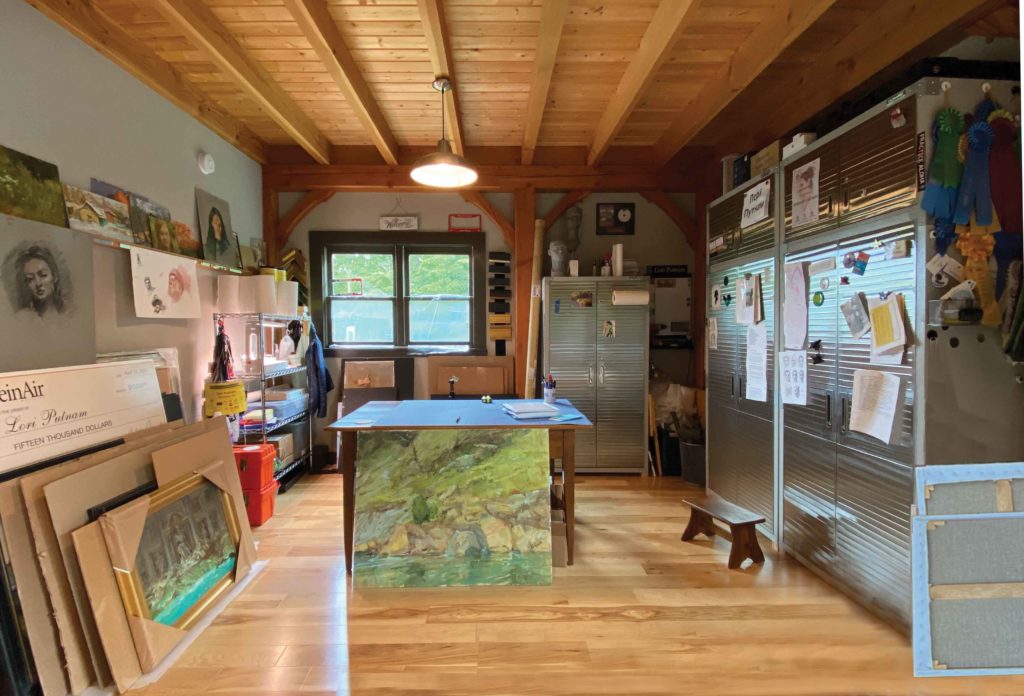
If you’re in the process of creating an art studio space, Lori has advice to help guide you. It’s first worth noting that while you need privacy, she says, “sometimes there just isn’t a space. I would rather be outside and that be my studio, than someplace that’s really, really dark. If your only option is the closet in the basement, then make the world your studio because that’s so much better and the light is going to be perfect.”
Back to creating a home art studio: “I think one of the most important things about a space is that first it feels the right size to you,” Lori said. “Some people prefer to be in a little tighter space. Some people prefer to have tall ceilings because they have a little bit of claustrophobia.”
Lori humbly says, “I can’t put my ideas on somebody else, but I can say that, for me, what has worked is this wonderful north light. It’s soft; it’s so pleasing when you walk in this room, combined with the really tall – 26-foot – ceilings. To a lot of people that would just be wasted space, but that feeling of being able to really breathe and not be closed in is perfect for me. It also allows the loft upstairs to have taller than average ceilings as well as a really large window at the peak.
“Being able to keep things stored and handy is helpful. If you happen to paint both in the studio and in plein air, then have a spot that’s just for your plein air gear. That was a biggie for me – to have a place where I know when I’m getting ready to go out and paint, everything is right there and I don’t have to go around and start digging to find stuff here and there. I think that’s huge.”
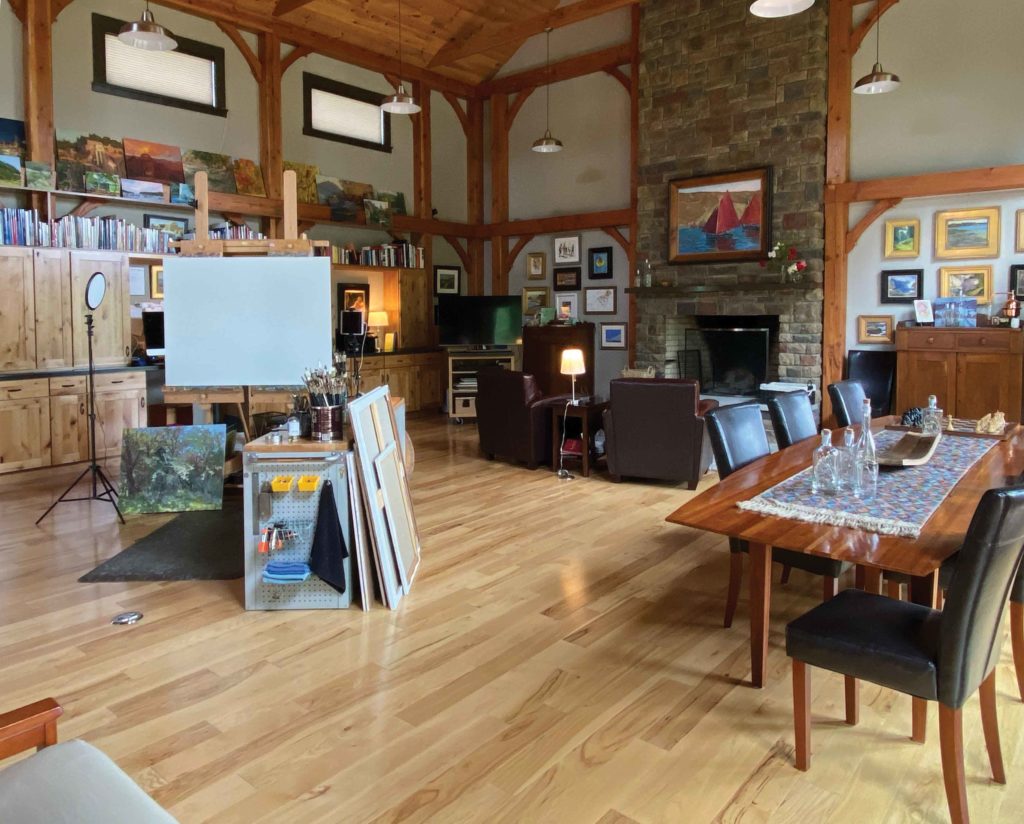


On Flooring
“Personally, if you’re able to have some say-so in the building of your space, or the space that you decide to rent, it’s great to have floors that are not gonna be hard on your feet, not going to hurt your legs, but that can wipe up if you care too. For instance, a concrete floor is great, but a concrete floor that isn’t suspended in some way, or doesn’t have some sort of really hefty mat where you stand most of the time will cause your legs to really ache especially, if you’re painting seven or eight hours a day.
“Our floor is hickory and I do have a big mat right in front of my easel. The hickory has such a nice finish on it that about once or twice a year I get down on my hands and knees and spend an hour and kind of get up the worst of the paint, usually before an open house or something, but I don’t have to worry about it. There’s no carpet, it can be easily wiped.”

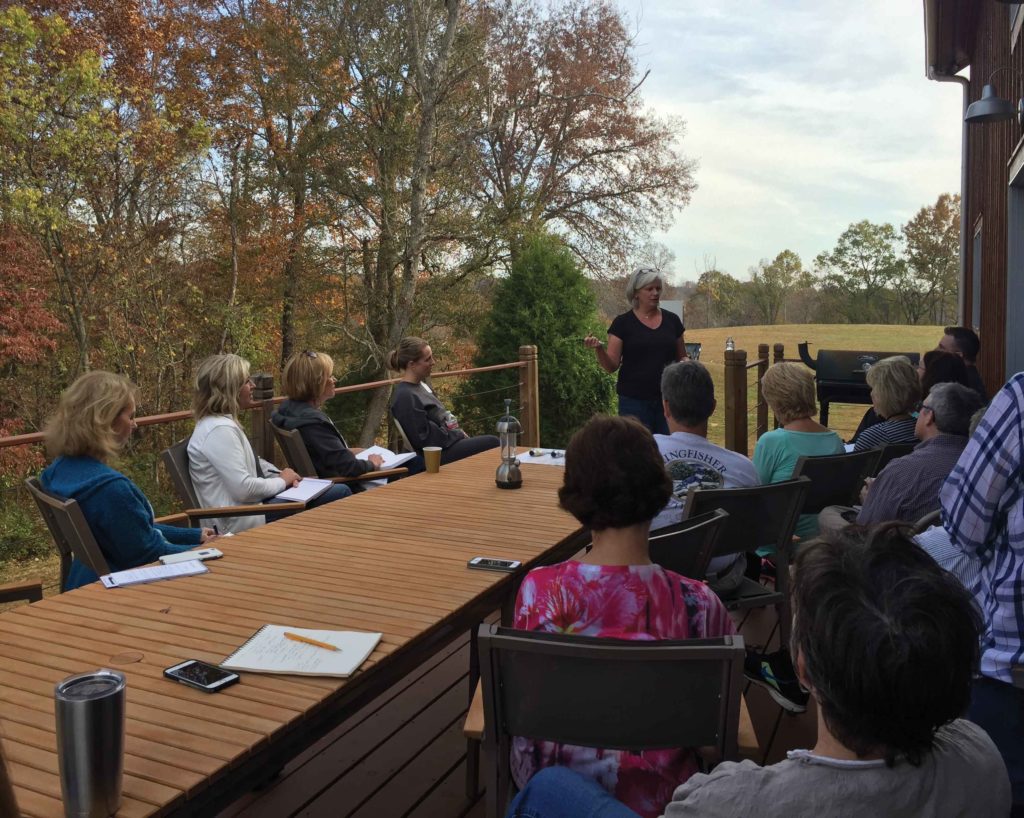
Under the Influence
Aside from the nuts and bolts of creating the perfect art studio, Lori advises to consider other surroundings than can affect you, such as playing motivating music or having silence. These subtle factors could make or break your painting experience.
“I don’t let myself have a bad painting day,” Lori said. “I might have a bad painting hour, but I don’t have the luxury of having a whole bad day. I know that if I’m having a bad painting hour, and I just take a break and turn on a different kind of music, or maybe turn on music if I haven’t had it on at all, it can be enough to reset my brain. For me, that will turn the painting around.
She adds that knowing what it is that can make you feel successful in your space can have a great impact, even if it’s something as simple as your favorite cup of coffee. “You can take a break and go, ’Okay, this is not going well, I’m just gonna go here and visit my coffee.’
“Ninety-five percent of this is a mind game, and so identify and write down the things that – even if they seem random – make you feel good. Try to incorporate those into your studio. We have some string lights, and I love lights, I’m like a little kid. I call them my happy lights, and so sometimes I just turn on my happy lights, and it just makes me happy and then I can get back to painting.”
But Does It Feel Good?
When it comes to having the best home art studio for you, Lori tells us that, “Honestly, it’s that feeling you get when you walk into it. If you cannot imagine yourself standing there, then it’s not the right place. I don’t care how much somebody else thinks it is, you have to be able to imagine yourself standing there; think about what you’re going to feel like, once your easel’s in there, once it’s five years down the road, and you’re still on there. If it doesn’t feel right and, given that you have the option, then look for somewhere else.
“I have a really good friend who has the greatest studio, and it is really just like a boat garage at a marina, where people generally keep their tools for working on their boats and all that stuff. She loves the water, so this is an inspirational place for her. But she just opens that door and bright sunshine comes in, and she literally tacks her canvas onto boards on the wall, and she paints. It is so perfect for her. It’s really about how you feel and not what anybody else expects. You can get wrapped up in ’Oh, so and so says I have to have north light and I have to have this and I have to add that. In the end, it just needs to feel good to you.”
Related Article > “How to Create the Perfect Art Studio,” a spotlight on the studio of William Schneider (article by Cherie Dawn Haas)

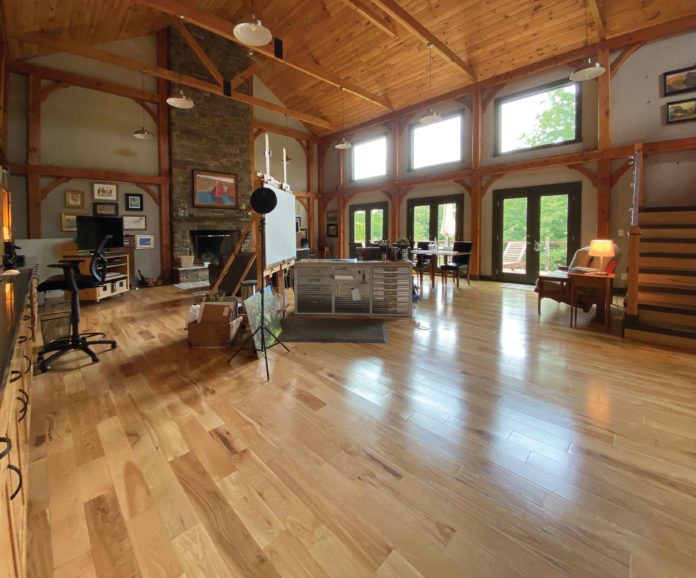







This is brilliant.
I have often thought I would be perfectly happy to live in a studio, a small kitchen tucked to one side, a bed tucked elsewhere..
My current studio space feels so cramped, I have to take a deep breath before I can start. I often just go outside.
Time to make plans.
Thank you for sharing.
Thanks for reading!
I have a small room in our house that I use . I want to put new lighting in it . I am curious about what kind of bulbs etc and where to place light .
Hi Anne! Great question – I think you’ll find this article from our sister site helpful: https://realismtoday.com/art-studio-lighting-basics/. Happy painting!
This is wonderful, Lori. Thank you for inviting us into your home. Question: my “shedio” is in a shed with a concrete floor and no windows. It is very difficult for me to get lighting right for painting and for photographing my paintings. Do you have any advice for lighting in a situation like mine? And the floor is concrete that is very hard on my lower back after long sessions. Do you have any recommendations for mats or something to make it easier for me to be comfortable standing on the concrete? Thank you in advance.
Hello, Guy! “Shedio” is a great nickname for your space! In regards to lighting, I think you’ll find this article from our sister site helpful: https://realismtoday.com/art-studio-lighting-basics/. Home improvement stores have a variety of mats; that might be a great place to start looking for something that will be comfortable and fit well within your space. Happy painting!
[…] Priorities: Her Home is in Her Art Studio (Inside Lori Putnam’s art studio) […]
[…] Related: • Learn more about Garin Baker’s art video workshop, “Intuitive Figure Painting” • Read about more inspiring art studios, such as Lori Putnam’s, in “Priorities: Her Home is in… […]